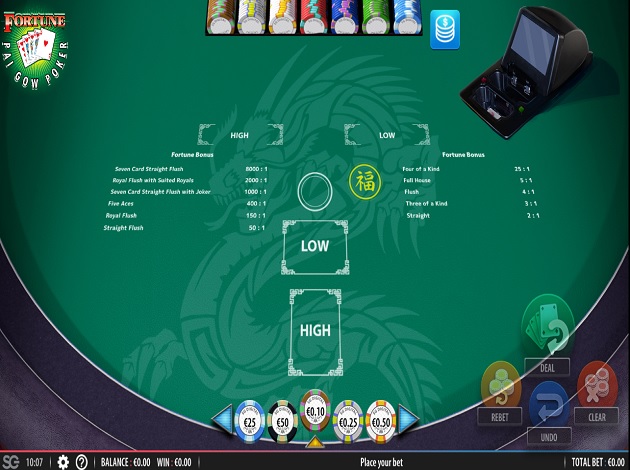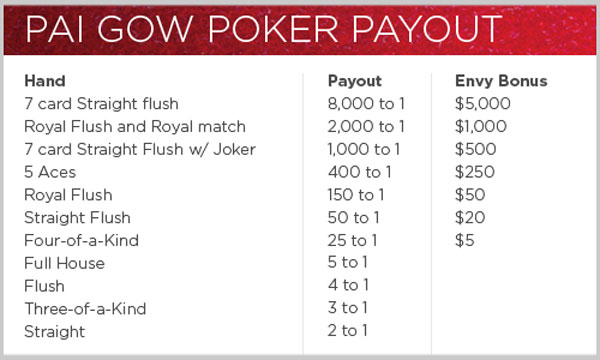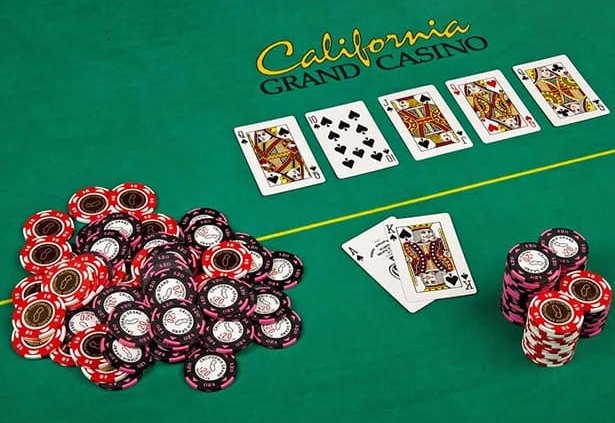Pai Gow Poker Dragon Hand. The suspense that comes from awaiting the outcome of a bad Pai Gow hand with a large wager is one of the most nerve racking features of the otherwise enjoyable game of Pai Gow Poker. We’ve all been there before, having just set a bad-hand such as a jack-high pai gow and hoping that by some miracle the dealer makes a. Your primary objective when playing Pai Gow poker is create two separate poker hands out of the seven cards you are dealt. The two hands must be comprised of a larger 5-card hand, also known as the “In front,” “behind,” or “on top.” Conversely, the second hand you need to assembly will be created from the remaining two cards.
This page is an introduction to how to play Pai Gow Poker, and it’s also a beginner’s tutorial for Pai Gow Poker strategy. I’ll write additional articles about Pai Gow Poker in the future which will go into more detail about the game and its strategies.
Pai Gow Poker is a poker-based game based on an ancient Chinese domino game called pai gow. The two games have some superficial similarities, but make no mistake, they ARE different games.
- 100% up to £1000
- 100% up to $300
How to Play Pai Gow Poker
Pai Gow Poker is not a true poker game. Like most casino games, in pai gow poker, you’re playing against the dealer, not against the other players. In a true poker game, you’re not playing against the dealer at all, you’re playing against the other players.
Pai Gow Poker is always played with a 53 card deck–a standard deck of cards with the inclusion of a joker as a wild card. The goal is to beat the dealer by putting together a better hand.
/Holdem-hands-56a105b25f9b58eba4b6c765.jpg)


In a game of Pai Gow Poker, everyone is dealt seven cards. Each player then makes two poker hands out these seven cards–a five card hand and a two card hand.
Pai Gow Poker Hand Setting
The poker hand rankings that are used in Pai Gow Poker are the standard poker hand rankings explained on this site’s poker strategy page, with one exception–a straight of ace to five is considered the 2nd highest straight possible. (That straight is called a “wheel.”)
The dealer also arranges her hand into a five card hand and a two card hand, but she doesn’t use her judgment when arranging her hands. She uses a set of prescribed rules called “the house way.” (See the similarities to blackjack?)
The player’s goal is to win BOTH hands, in which case she wins even money less a 5% commission.
If the player wins one hand but loses the other, the hand is considered a push, and her bet is returned.

One rule that all Pai Gow Poker players must follow is that when they arrange their hands, they’re forbidden from arranging their two card hand in a way that would make it a better hand than their five card hand. A player who arranges her hands in this way automatically loses; this is considered a “foul.” It’s not cheating, even though it breaks a rule–it’s just a dumb way to lose your money playing Pai Gow Poker.
Another quirk of Pai Gow Poker is that the player has the option of being the banker. If the player opts to be the banker, she needs enough of a bankroll to cover the bets at the table, and she also has to arrange her hands according to the “house way.” But a player can’t opt to bank every hand; the option rotates around the table. Most players don’t choose to be the banker at all anymore.

Pio Gow Poker
Pai Gow Poker House Edge
According to the Wizard of Odds, the house edge for a player who knows how to arrange her cards correctly in a game of Pai Gow Poker is 2.73%. The house edge for the banker is only 0.20%, so it’s a good idea to be the banker when you have the option. If you play the game long enough, and you choose to be the banker every time you get the chance, the overall house edge for the game is only 1.46%, making Pai Gow Poker a pretty good casino game, percentage-wise.
How To Play Pai Gao
How to Arrange Your Hands in Pai Gow Poker
If you want to get the detailed specifics for the correct Pai Gow Poker strategy, find a copy of Stanford Wong’s book Optimal Strategy for Pai Gow Poker. He goes into a lot of detail about the math of each situation and how to make the right decisions.
Another option is to visit Michael Shackleford’s site and just copy the “house way” even when you’re the player. You can find that link, labeled “Wizard of Odds”, in the paragraph before last.
But my preferred approach to Pai Gow Poker strategy is to apply a little bit of thought to each hand. This isn’t the mathematically correct approach every time, but I figure that even if I use perfect strategy, I’m still playing a negative expectation game, so why not?
According to Andrew Brisman, author of American Mensa Guide to Casino Gambling: Winning Ways, the best you can hope to achieve by playing perfectly at Pai Gow Poker is to shave 0.3% off the house edge. I’m not willing to study hard to gain 0.3% on a game that’s still a negative expectation game, so I’ll just relate the simple strategy for how to arrange your hands in Pai Gow Poker that Brisman shares in his book, and it boils down to a single sentence.
Arrange your hand so that you have the highest possible two card hand possible while still not having a two card hand that’s better than your five card hand.
This makes a lot of sense if you think about it. It doesn’t do you any good to have a full house for your five card hand if your two card hand is going to lose, because you won’t win any money. You’re better off with a three of a kind in your five card hand and a pair in your two card hand, because then you’ve at least got a chance of winning some money.
Pai Gow Poker Hands
You shouldn’t arrange your cards in such a way as to almost guarantee a push, in other words.
Pai Gow Poker Dragon Hand
Like most casino games, there are more nuances and details I could share about Pai Gow Poker, but this is meant to be an introduction to the game and its strategies, so I’ll leave the other details for future articles on the subject.